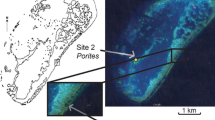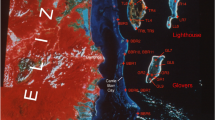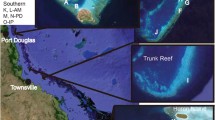Abstract
It is a widely held concept that tropical coral reefs in shallower water with branched acroporid corals should accrete faster than those in deeper water dominated by massive corals. Results from a study of Holocene development of the largest Atlantic reef system, including paleo-waterdepth data, challenge these concepts. In Belize barrier and atoll reefs, reef accretion-rates range from 0.46 to 7.50 m/kyr, and average 3.03 m/kyr, as measured along 33 dated reef sections. Interestingly, accretion-rates increase with increasing paleo-waterdepth, and sections dominated by massive corals accumulated even slightly faster than those with branched acroporids. Published data from some other reef locations reveal no significant trends when plotting reef accretion-rate versus paleo-waterdepth, also indicating that the above-mentioned concepts should be questioned. Massive corals apparently are more resistant and accrete in lower disturbance conditions in slightly deeper water (5–10 m) and higher accomodation (space available for sediment deposition) as compared to shallow water (0–5 m) branched acroporids, which repeatedly get broken and leveled out during tropical cyclones.





Similar content being viewed by others
References
Adey W (1975) The algal ridges and coral reefs of St. Croix, their structure and Holocene development. Atoll Res Bull 187:1–67
Bosscher H, Schlager W (1992) Computer simulation of reef growth. Sedimentology 39:503–512
Cabioch GF, Montaggioni LF, Faure G (1995) Holocene initiation and development of New Caledonian fringing reefs, SW Pacific. Coral Reefs 14:131–140
Camoin GF, Montaggioni LF, Braithwaite CJR (2004) Late glacial to post glacial sea levels in the western Indian Ocean. Mar Geol 206:119–146
Chave KE, Smith SV, Roy KJ (1972) Carbonate production by coral reefs. Mar Geol 12:123–140
Davies PJ, Hopley D (1983) Growth fabrics and growth rates of Holocene reefs in the Great Barrier Reef. BMR J Austral Geol Geophys 8:237–251
Davies PJ, Marshall JF, Hopley D (1985) Relationships between reef growth and sea level in the Great Barrier Reef. Proc 5th Int Coral Reef Symp Tahiti 3:95–103
Dullo WC (2005) Coral growth and reef growth: a brief review. Facies 51:33–48
Gischler E (2006) Comment on “Corrected western Atlantic sea-level curve for the last 11,000 years based on calibrated 14C dates from Acropora palmata framework and intertidal mangrove peat” by Toscano and Macintyre. Coral Reefs 22:257–270 (2003), and their response in Coral Reefs 24:187–190 (2005). Coral Reefs 25:273–279
Gischler E, Hudson JH (1998) Holocene development of three isolated carbonate platforms, Belize, Central America. Mar Geol 144:333–347
Gischler E, Hudson JH (2004) Holocene development of the Belize Barrier Reef. Sed Geol 164:223–236
Gischler, E, Lomando AJ (2000) Isolated carbonate platforms of Belize, Central America: sedimentary facies, late Quaternary history and controlling factors. In: Insalaco E, Skelton PW, Palmer TJ (eds) Carbonate platform systems: components and interactions. Geol Soc Spec Publ 178:135–146
Hubbard DK, Burke RB, Gill IP (1998) Where’s the reef: the role of framework in the Holocene. Carbonates Evaporites 13:3–9
Hubbard DK, Gill I, Burke RB (2005) Holocene reef development in the Caribbean: geological perspectives revisited. Geol Soc Am, Abstr Progs, 179–214
Hubbard DK, Miller AI, Scaturo D (1990) Production and cycling of calcium carbonate in a shelf-edge reef system (St. Croix, U.S. Virgin Islands): applications to the nature of reef systems in the fossil record. J Sed Petrol 60:335–360
Hughes TP, Connell JH (1999) Multiple stressors on coral reefs: a long term perspective. Limnol Oceanogr 44:932–940
James NP, Ginsburg RN, Marszalek DS, Choquette PW (1976) Facies and fabric specificity of early subsea cements in shallow Belize (British Honduras) reefs. J Sed Petrol 46:523–544
Kiene WE, Hutchings P (1994) Bioerosion experiments at Lizard Island, Great Barrier Reef. Coral Reefs 13:91–98
Kleypas JA, Buddemeier RW, Archer D, Gattuso JP, Langdon C, Opdyke BN (1999) Geochemical consequences of increased atmopsheric carbon dioxide on coral reefs. Science 284:118–120
Macintyre IG, Burke RB, Stuckenrath R (1981) Core holes in the outer fore reef off Carrie Box Cay, Belize: a key to the Holocene history of the Belizean barrier reef complex. Proc 4th Int Coral Reef Symp Manila 1:567–574
Macintyre IG, Multer HG, Zankl H, Hubbard DK, Weiss MP, Stuckenrath R (1985) Growth and depositional facies of a windward reef complex (Nonsuch Bay, Antigua, W.I.). Proc 5th Int Coral Reef Symp Tahiti 6:605–610
Montaggioni LF (2005) History of Indo-Pacific coral reef systems since the last glaciation: development patterns and controlling factors. Earth Sci Rev 71:1–75
Montaggioni LF, Cabioch G, Camoin GF, Bard E, Ribaud-Laurenti A, Faure G, Déjardin P, Récy J (1997) Continuous record of reef growth over the past 14 k.y. on the mid-Pacific island of Tahiti. Geology 25:555–558
Muller-Parker G, D’Elia CF (1997) Interaction between corals and their symbiotic algae. In: Birkeland C (ed) Life and death of coral reefs. Chapman & Hall, New York, pp 96–113
Pandolfi JM, Bradbury RH, Sala E, Hughes TP, Bjorndal KA, Cooke RG, McArdle D, McClenahan L, Newman MJH, Paredes G, Warner RR, Jackson JBC (2003) Global trajectories of the long-term decline of coral reef ecosystems. Science 301:955–958
Schlager W (1981) The paradox of drowned reefs and carbonate platforms. Geol Soc Amer Bull 92:197–211
Shinn EA, Hudson JH, Halley RB, Lidz B, Robbin DM, Macintyre IG (1982) Geology and sediment accumulation rates at Carrie Bow Cay, Belize. In: Rützler K, Macintyre IG (eds) The Atlantic barrier reef ecosystem at Carrie Bow Cay, Belize, Smiths Contr Mar Sci 12:63–75
Vogel K, Gektidis M, Golubic S, Kiene WE, Radtke G (2000) Experimental studies on microbial erosion at Lee Stocking Island, Bahamas and One Tree Island, Great Barrier Reef, Australia: implications for paleoecological reconstructions. Lethaia 33:190–204
Acknowledgements
I thank the Deutsche Forschungsgemeinschaft (DFG; German Research Foundation) and Chevron Overseas Petroleum Inc. for financing the projects to obtain the core material. I am grateful to H. Hudson, N. Jackson Jr., A. Lomando, and G. Meyer who were reliable partners during drilling operations. The comments by D. Barnes, R. Ginsburg, B. Rosen, journal reviewers G. Cabioch and J. Webster, and editors C. Dullo and L. Montaggioni improved the paper and are gratefully acknowledged.
Author information
Authors and Affiliations
Corresponding author
Rights and permissions
About this article
Cite this article
Gischler, E. Accretion patterns in Holocene tropical coral reefs: do massive coral reefs in deeper water with slowly growing corals accrete faster than shallower branched coral reefs with rapidly growing corals?. Int J Earth Sci (Geol Rundsch) 97, 851–859 (2008). https://doi.org/10.1007/s00531-007-0201-3
Received:
Accepted:
Published:
Issue Date:
DOI: https://doi.org/10.1007/s00531-007-0201-3




